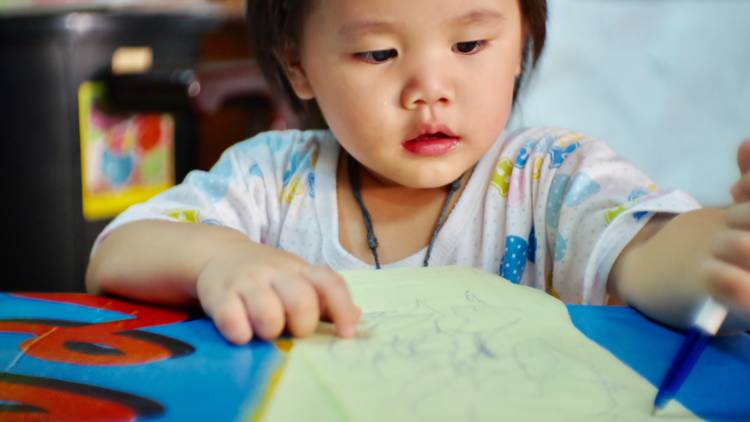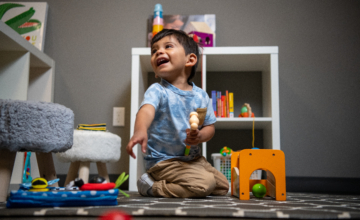When children are very young, art is all about discovering what these cool things called crayons and markers are and what they can do.
There are three basic stages of drawing, starting with scribbles at 15 months all the way through drawing a picture by age 5. Don’t be surprised if your child shows some of these skills early, and others late. That’s just how children grow. The key is offering lots of chances to play with art and drawing materials, starting in the early years.
Stage 1: Random Scribbling (15 months to 2½ years)
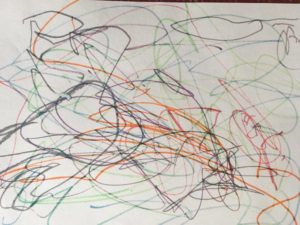
An example of the first stage of drawing: random scribbling.
At first, young children are just figuring out that their actions result in lines and scribbles on the page. They use large movements from the shoulder to draw, and hold the crayon or marker in their fists. They’re very interested in the sensory experience of creating art: the way the crayon, play dough, or finger paint feels and smells (and, sometimes, tastes!).
Stage 2: Controlled Scribbling: Lines and Patterns (2 years to 3 years)
As children develop better hand and finger skills, their scribbles become more controlled. Toddlers may make repeated marks on the page—open circles or diagonal, curved, horizontal, or vertical lines. Over time, children begin to hold the crayon or marker with their fingers, instead of their fists.
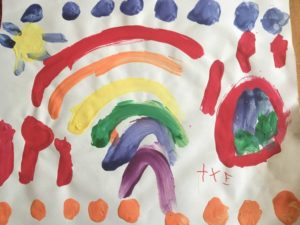
The second stage of drawing includes controlled scribbling, lines and patterns.
Toddlers now understand that their drawings can convey meaning. My daughter’s first “drawing” at age 2 ½ was a series of dots on the page. She looked up at me with a grin on her face and said, “Raining!” At this stage, toddlers know that print has meaning and that writing is made up of lines, dots, and curves. While they may not write actual letters yet, you might see letter-like shapes in their drawings.
Stage 3: Pictures of Objects or People (3 years to 5 years)
Many adults think of a drawing as a picture of something. Adults decide what we’ll draw and then do it. This ability to think of an image and then put it on the page is a symbolic thinking skill that takes time to develop. Until now, children scribble and then decide what their picture is.
In the preschool years, you will see your child begin to plan what she will draw before starting: “I’m going to draw Mommy.” Your child will start adding more detail and using more color in her pictures. Preschoolers also start holding crayons with their thumb, pointer, and middle fingers (called a “tripod” grasp), which gives them more control in drawing and writing.
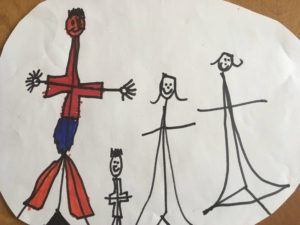
In the third stage of drawing, children start drawing objects and people.
Children’s first pictures tend to build off circles. They often draw sun-like shapes—a circle with lots of stick “rays” shooting out—or a person drawn as a circle with arm/leg lines and some human features (eyes, mouth, hair). Your child may start to sign his picture or scribble some “words” to describe his work.
So what can you do to nurture early art experiences?
Make art a regular part of playtime.
Start off with chunky crayons or washable markers. Sometimes it helps young children if you tape the paper down on the table so it doesn’t move as they draw. As your child grows, he may enjoy washable paints, child-safe scissors and glue, and play dough.
Ditch the instructions.
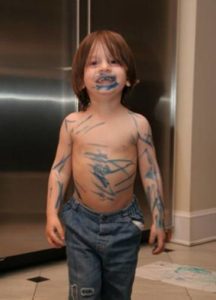
Check out this photo of my 2-year-old after he thoroughly “explored” markers. How’s that for art?
Let your child experiment and explore. At this age, art doesn’t need instructions (except reminders not to eat the glue!). Toddlers thrive on this independence and choice. By sitting nearby and taking pleasure in your child’s work, you are providing all the guidance she needs. Notice the process, not just the product.
As parents, we often focus on the “what” of art: “What’s that a picture of?” And sometimes we get hung up on the fact that trees should be green, not purple. Sometimes we quiz: “What color is that?” Or offer automatic praise: “That’s great!” Instead, take a few moments to really look at your child’s work and describe what you see: “Look at the lines you are making—there are so many of them!” Or, “Those colors make me feel happy.” Or just, “Tell me about your picture.”
Experiment with art materials.
Sure, you can paint with brushes, but think about letting your preschooler paint with cotton balls, q-tips, sponges, string—you name it. Give your child crayons to rub over a textured surface (like a coin or a screen). Draw with chalk outside on the sidewalk. Explore color mixing by combining paint colors. Offer a variety of “stuff” (boxes, old magazines, the red net bag that holds onions, used corks, etc.) and let your child construct a sculpture with masking tape.
Use art to help your child express strong feelings.
Is your child having a tantrum? Offer some play dough or set out markers and paper and suggest he make an angry picture. Creative activities can sometimes help children express feelings that are too overwhelming to share in words.
Early art experiences offer lots of benefits, supporting the development of hand and finger control, problem-solving and symbolic thinking skills, and more. These are all important for the transition to school. But the most important benefit of creative play? Giving children an opportunity to tap into the magic of their own imaginations—which is what being a child is all about.


